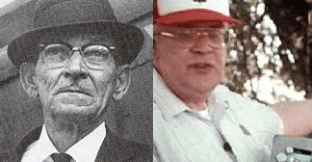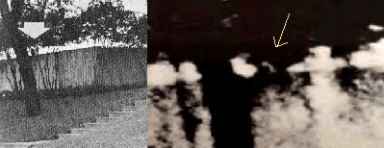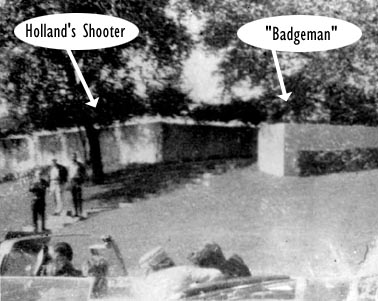Mack and White have each argued that Arnold did not tell his story to gain publicity for himself,
and was in fact quite reluctant to come forward. “He is a very shy man and never sought to have
his story made public,” White says.
![]() Mack points out that Arnold gave his initial account to Earl
Golz believing his identity would remain confidential.
Mack points out that Arnold gave his initial account to Earl
Golz believing his identity would remain confidential.
![]() Golz confirmed this to Henry Hurt in
1982, “explaining that at the last minute his editor refused to run the story without giving
Arnold’s identity.”
Golz confirmed this to Henry Hurt in
1982, “explaining that at the last minute his editor refused to run the story without giving
Arnold’s identity.”
![]()
“It is possible, I suppose,” Mack says, “that parts of his story were exaggerated; but unless you
know the person, as several of us did, you cannot simply assume he was the type of person who
would pull off a scam. There’s certainly no indication that in the nine years following the show
[The Men Who Killed Kennedy] that he did anything whatsoever to capitalize on, or gain
notoriety from, the experience. In fact, he turned down requests for other interviews.”
![]()
“Finally,” Mack says, responding to another common accusation, “having interviewed the late
Gordon Arnold several times, and speaking with others who have also done so, there is
absolutely no indication he was ‘emotionally disturbed’ at any time.”
![]()
If one chooses to accept Gordon Arnold’s story, however, there is another slight problem that needs to be addressed.
After the release of the Warren Report and its 26 volumes of testimony and exhibits, conspiracy theorists seized upon the testimony of Union Terminal Railroad signal supervisor S. M. Holland to prove there had been a shot fired from the grassy knoll.

Knoll witnesses S. M. Holland (left) and Gordon Arnold
At his Warren Commission deposition, Holland testified that he viewed the motorcade from the
railroad bridge overlooking Elm Street, and that during the assassination, he heard four reports,
![]() three of which sounded like they came from “the upper part of the street,” towards the Texas
School Book Depository,
three of which sounded like they came from “the upper part of the street,” towards the Texas
School Book Depository,
![]() but one of which (either the third or the fourth) came “from under
those trees” on the grassy knoll.
but one of which (either the third or the fourth) came “from under
those trees” on the grassy knoll.
![]()
Concurrent with this report from the knoll area, he said, “a puff of smoke came out about 6 or 8
feet above the ground right out from under those trees . . . like someone had thrown a
firecracker, or something out, and that is just about the way it sounded. It wasn’t as loud as the
previous reports or shots.”
![]() It was “just like somebody had thrown a firecracker and left a little
puff of smoke there; it was just laying there,” he told investigator Josiah Thompson two years
later. “It was a white smoke; it wasn’t a black smoke or like a black powder. It was like a puff of
a cigarette, but it was about nine feet off the ground.”
It was “just like somebody had thrown a firecracker and left a little
puff of smoke there; it was just laying there,” he told investigator Josiah Thompson two years
later. “It was a white smoke; it wasn’t a black smoke or like a black powder. It was like a puff of
a cigarette, but it was about nine feet off the ground.”
![]()
Holland ran “around the end of this overpass, behind the fence to see if I could see anyone up
there behind the fence.” “Of course, this was this sea of cars in there and . . . [there] wasn’t an
inch in there that wasn’t automobiles and I couldn’t see up in that corner. I ran on up to the
corner of this fence behind the building. By the time I got there there were 12 or 15 policemen
and plainclothesmen, and we looked for empty shells around there for quite a while . . .,”
![]() though none was ever found.
though none was ever found.
There was one thing Holland found suspicious, however. He testified that behind the fence, at
what he estimated to be the same location as the puff of smoke he had seen, “there was a station
wagon backed up toward the fence, about the third car down, and a spot, I’d say 3 foot by 2 foot,
looked to me like somebody had been standing there for a long period. . . . and also mud upon
the bumper of that station wagon. . . . [It looked] like someone had been standing there for a long
time . . . It was muddy, and you could have if you could have counted them, I imagine it would
have been a hundred tracks just in that one location. . . . [There was] Mud on the bumper in two
spots. . . . as if someone had cleaned their foot, or stood up on the bumper to see over the fence. .
. . Because, you couldn’t very well see over it standing down in the mud, or standing on the
ground . . .”
![]()
Union Terminal track supervisor Richard C. Dodd added that “there were tracks and cigarette
butts laying where someone had been standing on the bumper looking over the fence.”
![]()
Influential author Mark Lane used Holland as a key witness in his 1966 book Rush to Judgment;
and Josiah Thompson did the same in his 1967 volume, Six Seconds in Dallas, devoting
numerous pages to quotations from Holland. Holland specified to Thompson that the first,
second, and fourth shots had a similar sound to them, while “the third shot was not so loud; it
was like it came from a .38 pistol, compared with a high-powered rifle.”
![]() The third and fourth
shots, he said, were nearly simultaneous.
The third and fourth
shots, he said, were nearly simultaneous.
![]()
Holland believed that the third shot was fired from behind the stockade fence on the knoll, from
the point where he the puff of smoke originated.
![]() He took both Mark Lane and Josiah
Thompson to the precise location he recalled, behind the stockade fence.
He took both Mark Lane and Josiah
Thompson to the precise location he recalled, behind the stockade fence.
![]() Thompson even found
something in Mary Moorman’s Polaroid that he believed to be a possible assassin behind the
stockade fence,
Thompson even found
something in Mary Moorman’s Polaroid that he believed to be a possible assassin behind the
stockade fence,
![]() and S. M. Holland was impressed.
and S. M. Holland was impressed.
“Well, now you have something here,” Holland told Thompson when he saw the enlargement. “.
. . Well, do you know I think that you’re looking right down at the barrel of that gun right
now!”
![]()

Left: S. M. Holland stands where he thought a shot originated
Right: An image discovered by Josiah Thompson in Mary Moorman’s Polaroid
Are there reasons to doubt S. M. Holland’s version of the assassination? Certainly; for one thing, Holland was only one of at least fourteen witnesses who viewed the motorcade from the railroad bridge, and the eyewitnesses disagreed about what happened.
While mail clerk Austin L. Miller, hostler helper Nolan H. Potter, switchman Walter Luke
Winborn, and others agreed with Holland about the smoke,
![]() they and most of the other overpass
witnesses heard precisely three shots and could not agree on their origin. Officer James W.
Foster thought they “came from back in toward the corner of Elm and Houston Streets,”
they and most of the other overpass
witnesses heard precisely three shots and could not agree on their origin. Officer James W.
Foster thought they “came from back in toward the corner of Elm and Houston Streets,”
![]() toward
the Texas School Book Depository; electrician Frank E. Reilly thought they all came from the
knoll;
toward
the Texas School Book Depository; electrician Frank E. Reilly thought they all came from the
knoll;
![]() Austin Miller thought they sounded as if they came “from right there in the [President’s]
car.”
Austin Miller thought they sounded as if they came “from right there in the [President’s]
car.”
![]() Nolan Potter, Walter Winborn, and hostler Curtis F. Bishop didn’t know where the shots
came from.
Nolan Potter, Walter Winborn, and hostler Curtis F. Bishop didn’t know where the shots
came from.
![]()
Did a rifle on the knoll emit the puff of smoke recalled by some of the witnesses? Ever since the
time of the Civil War, rifles have been virtually smokeless, and Lee Harvey Oswald’s
Mannlicher-Carcano is typical in that respect.
![]() Are there other possible explanations for such
smoke? Of course.
Are there other possible explanations for such
smoke? Of course.
For example, S. M. Holland himself said the smoke “was like a puff of a cigarette,”
![]() and Walter
Winborn also said it looked like “somebody had taken a puff off of a cigarette . . .”
and Walter
Winborn also said it looked like “somebody had taken a puff off of a cigarette . . .”
![]() Richard
Dodd observed “tracks and cigarette butts” at the spot he and Holland said the smoke
originated.
Richard
Dodd observed “tracks and cigarette butts” at the spot he and Holland said the smoke
originated.
![]() It seems reasonable enough to suggest that a spectator behind the fence, possibly
one of the men noticed by eyewitness Lee Bowers,
It seems reasonable enough to suggest that a spectator behind the fence, possibly
one of the men noticed by eyewitness Lee Bowers,
![]() may have been smoking.
may have been smoking.
On the other hand, railroad car inspector James L. Simmons told the FBI “he thought he saw
exhaust fumes of smoke near the embankment in front of the Texas School Depository
Building,” and “it was his opinion the shots came from the direction of the Texas School
Depository Building.”
![]()
Machinist Clemon Earl Johnson also noticed “smoke, lots of puffs of smoke,” he told researcher
Larry Sneed, “but I was of the opinion that the smoke was coming out of those motorcycles. The
smoke was coming up off the ground out where the motorcycles were, not on the grassy knoll. A
lot of them said they saw smoke come out of the grassy knoll, but I didn’t. Maybe it’s because
they were looking that way, and I was looking down on the car. But the smoke cleared up pretty
quick after all the cars and motorcycles left. I’ve always thought the smoke came from those
motorcycles. . . . But Holland and Dodd, if both were living today, they’d almost fight you that
they saw smoke coming from out of those bushes. They swore they were looking right at the
bushes at the time. You couldn’t talk to them. Those guys’ heads were set.”
![]()
Despite all of this, for over a decade Holland’s scenario was the theory, endorsed in not only
Rush to Judgment and Six Seconds in Dallas, but other seminal conspiracy books like Sylvia
Meagher’s Accessories after the Fact (1967),
![]() Jim Garrison’s A Heritage of Stone (1970),
Jim Garrison’s A Heritage of Stone (1970),
![]() and
Robert Sam Anson’s “They’ve Killed the President!” (1975).
and
Robert Sam Anson’s “They’ve Killed the President!” (1975).
![]()
But Gordon Arnold claimed that, not just one, but numerous shots came from behind the picket
fence; and not where S. M. Holland specifically placed the shooter, which would have been a
considerable distance to Arnold’s right; but rather, the young soldier felt the first shot, only
inches over his left shoulder:
![]() so close, he told Henry Hurt in 1982, that when the shots began,
“I thought they were shooting at me”;
so close, he told Henry Hurt in 1982, that when the shots began,
“I thought they were shooting at me”;
![]() and, as he stated even more dramatically in The Men
Who Killed Kennedy, “. . . when a bullet goes past your ear and your eardrum feels like it’s
coming out the other side of your head, it’s close. That’s why I thought I was shot.”
and, as he stated even more dramatically in The Men
Who Killed Kennedy, “. . . when a bullet goes past your ear and your eardrum feels like it’s
coming out the other side of your head, it’s close. That’s why I thought I was shot.”
![]()

So if we choose to believe that there was a shooter on the grassy knoll, whose version do we believe: S. M. Holland’s or Gordon Arnold’s? And if one has to be false, what guarantee do we have that there is any truth to either one?